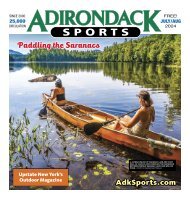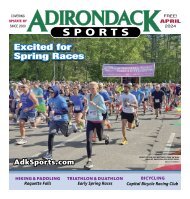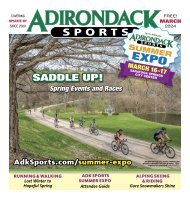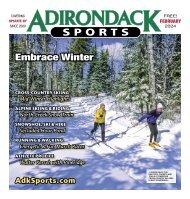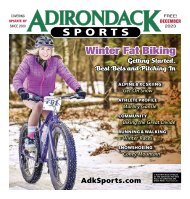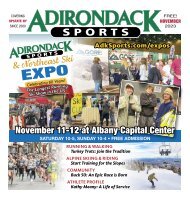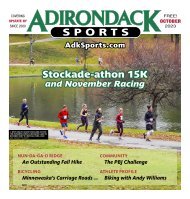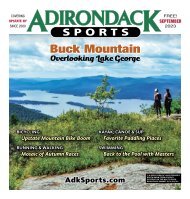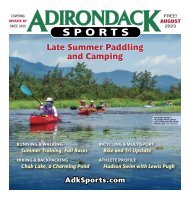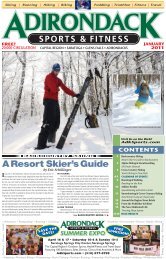Adirondack Sports July 2023
In this issue: 5 NEWS BRIEFS 7 BICYCLING: Late Summer Events 11 PADDLE, HIKE & CAMP: Boreas Ponds Update 15 RUNNING & WALKING: Marathon and Half Season 19 RECREATION: Prevent Aquatic Invasive Species 20 ATHLETE PROFILE: Running with Ramon Dominguez 22-29 CALENDAR OF EVENTS: Many Summer Things To Do 31 PADDLING: Beginner Whitewater Kayaking 35 NON-MEDICATED LIFE: Preventing Lyme Disease 36-39 RACE RESULTS: Top Finishers in June Events
In this issue:
5 NEWS BRIEFS
7 BICYCLING: Late Summer Events
11 PADDLE, HIKE & CAMP: Boreas Ponds Update
15 RUNNING & WALKING: Marathon and Half Season
19 RECREATION: Prevent Aquatic Invasive Species
20 ATHLETE PROFILE: Running with Ramon Dominguez
22-29 CALENDAR OF EVENTS: Many Summer Things To Do
31 PADDLING: Beginner Whitewater Kayaking
35 NON-MEDICATED LIFE: Preventing Lyme Disease
36-39 RACE RESULTS: Top Finishers in June Events
You also want an ePaper? Increase the reach of your titles
YUMPU automatically turns print PDFs into web optimized ePapers that Google loves.
PADDLING Continued from page 31<br />
or floods can change the shape of rapids,<br />
thus vastly altering their classification.<br />
The classifications are as follows:<br />
Class I – Moving water with a few riffles<br />
and small waves. Few or no obstructions.<br />
Class II – Easy rapids with smaller<br />
waves, clear channels that are obvious<br />
without scouting. Some maneuvering<br />
might be required. Class III – Rapids with<br />
high, irregular waves. Narrow passages<br />
that often require precise maneuvering.<br />
Classic IV – Long, difficult rapids with<br />
constricted passages that often require<br />
complex maneuvering in turbulent water.<br />
The course may be hard to determine,<br />
and scouting is often necessary. Classic<br />
5 – Extremely difficult, long, and very violent<br />
rapids with highly congested routes,<br />
which should be scouted from shore.<br />
Rescue conditions are difficult, and there<br />
is a significant hazard to life in the event<br />
of a mishap. Class VI – The difficulties of<br />
Class V carried to the extreme. Nearly<br />
impossible and very dangerous. For teams<br />
of experts only. Involves risk of life. Class<br />
VI rapids are not commercially raftable.<br />
Rivers and creeks can be incredible<br />
natural forces subject to change at<br />
any time. Fortunately, there are digital<br />
resources available from USGS, NOAA<br />
and others that let you monitor the conditions<br />
often in real time to help plan<br />
your trips. Understanding the classification<br />
systems and the factors that can<br />
alter them leads to more fun on the water<br />
and a safer experience. With respect to<br />
safety, paddlers should not paddle alone,<br />
they should always wear a personal flotation<br />
device (PFD), and should not<br />
overestimate their skill level and should<br />
always be mindful of weather and river<br />
classifications.<br />
◀ ED MARTUSCELLO<br />
TEACHING ME HOW TO ROLL<br />
IN THE FULTON COUNTY<br />
YMCA LAST WINTER.<br />
Local Places to Paddle – Within a<br />
one- to two-hour radius of the Capital<br />
Region and <strong>Adirondack</strong>s we are fortunate<br />
to have some fantastic whitewater<br />
resources. This is just a short list of local<br />
paddling opportunities:<br />
Hudson River – This iconic waterway<br />
offers experts and beginners alike some of<br />
the most incredible whitewater opportunities.<br />
The Upper Hudson, including the<br />
Indian River, has been a top destination<br />
for expert kayakers and whitewater rafting<br />
companies for decades. Trips and outfitters<br />
often originate out of the North Creek<br />
area and start on the Indian River which<br />
then joins the Hudson. This 14-mile paddle<br />
through “The Gorge,” which consists<br />
of class III-IV rapids can be an incredible<br />
experience that creates lifelong memories.<br />
For beginners, the section between<br />
North River and North Creek is a good<br />
option, with easy access just above the<br />
rest area on NY Route 28 in North River.<br />
This section of the river provides about<br />
five miles of slow-moving water, with a<br />
few Class I-II rapids, and some incredible<br />
scenery – which no doubt will make<br />
you want to come back for more. At the<br />
right water levels, the next section of the<br />
Hudson between North Creek, Riparious<br />
and Glen offers about 14 miles of Class<br />
I-III rapids. There is easy access to the<br />
river from North Creek behind the downtown<br />
pavilion. This section is livelier and<br />
has some incredible scenery.<br />
Schroon River – Down the road from<br />
the Hudson, but still part of its big brother’s<br />
tributary. The Schroon with the right<br />
water levels can also offer some beautiful<br />
views and lively Class I-III rapids.<br />
The 6.5-mile section below the dam in<br />
Starbuckville to the takeout at Riverbank<br />
◀ SALLY DAWES ON THE<br />
POULTNEY RIVER. SHE’S<br />
AN AMAZING TEACHER<br />
AND EXPERT PADDLER.<br />
just north of Exit 24 of<br />
the Northway takes you<br />
through “<strong>Adirondack</strong><br />
scenery,” while also<br />
offering some exhilarating<br />
rapids. Water levels<br />
usually remain high<br />
enough until Memorial<br />
Day and after significant<br />
rain events to<br />
run this section of the<br />
Schroon. When you’re<br />
done on the river, complete<br />
your <strong>Adirondack</strong><br />
experience by visiting<br />
the Crossroads Country<br />
Store in Chestertown, The Hub in Brant<br />
Lake, or <strong>Adirondack</strong> General Store in<br />
<strong>Adirondack</strong>.<br />
Sacandaga River – Another river with<br />
many branches that’s also a tributary<br />
of the Hudson River is the Sacandaga.<br />
With the right conditions, it offers many<br />
whitewater opportunities. One of the<br />
most popular, and reliable, due to dam<br />
releases is the Class I-III section between<br />
the Stewart’s Dam and the Hudson River.<br />
From the Sacandaga Outdoor Center in<br />
Hadley, kayaking, rafting, and tubing can<br />
all be experienced in a family-friendly<br />
atmosphere. But don’t let this three-mile<br />
stretch of river, which can be accessed<br />
just below the Stewart’s Dam, fool you.<br />
There are a few very powerful play waves<br />
on this stretch, and capsizing can lead to a<br />
long swim especially at the bottom of this<br />
run. If this occurs, you may find yourself<br />
starting your trip on the Sacandaga, and<br />
ending it several hundred yards down the<br />
Hudson River!<br />
Deerfield River – This diverse and historical<br />
river in our backyard runs for 76<br />
miles from southern Vermont through<br />
northwestern Massachusetts all the way<br />
to the Connecticut River. The popular Fife<br />
Brook section of the river is located in<br />
Charlemont, Mass., and is mostly beginner-friendly<br />
with Class I-II rapids – perfect<br />
for practicing and honing skills. There is<br />
also one Class III rapid called “Zoar Gap,”<br />
which if not respected will send paddlers for<br />
an exuberant swim. On weekends, onlookers<br />
often can be seen on the road above the<br />
Gap offering encouragement to those about<br />
to run it, and to witness the carnage that<br />
ensues to those that “swim” the gap.<br />
The Fife Brook section of the river<br />
offers over eight miles of paddling with<br />
JULY <strong>2023</strong> 33<br />
spectacular views, through pristine wilderness<br />
and many deep valleys. This is<br />
also a dam release, popular waterway<br />
pursued by several outdoor outfitters for<br />
fishing, rafting, tubing and kayaking. For<br />
a much more challenging experience just<br />
upstream of the Fife Brook, the Monroe<br />
Bridge section of the Deerfield (also called<br />
the “Dryway”), is another popular option<br />
for more expert paddlers. This section of<br />
the river, which is just shy of three miles<br />
long, offers Class III-IV level rapids and is<br />
also controlled by dam releases. If you’re<br />
interested in these rivers, consider one<br />
of the local outfitters for a trip, including<br />
Zoar Outdoor, Crabapple Whitewater, and<br />
Berkshire Outfitters.<br />
Moose and Beaver Rivers – Although<br />
not generally for beginners, I would<br />
be remiss if I didn’t mention these two<br />
fabled New York whitewater destinations.<br />
Each of these rivers offers some of the<br />
best scenery and most exhilarating and<br />
demanding Class IV-V rapids around. If<br />
interested, Alex Barham of Cazenovia, has<br />
some amazing online YouTube videos.<br />
In addition, the annual Beaver Festival<br />
attracts hundreds of the paddlers to this<br />
area on Labor Day weekend.<br />
My first brush with whitewater kayaking<br />
was over 35 years ago. I was on a whitewater<br />
rafting trip through the Hudson<br />
Gorge with friends from high school,<br />
and amongst the flotilla of over 20 rafts,<br />
there were about a dozen kayakers. As we<br />
entered the Indian River, which is about<br />
2.5 miles upstream of the Hudson, I was<br />
in awe of the sheer beauty of where I was<br />
– and the power of the water – and it only<br />
got better as the trip advanced through<br />
the “Gorge.” It was during this trip that I<br />
hatched the idea of someday running this<br />
in a kayak. I’m not sure if this will ever<br />
happen, but that’s OK.<br />
As Norm Labbe of Clifton Park, a<br />
very experienced paddler mentioned, “It<br />
always allows you to challenge yourself as<br />
much as you like. Some paddlers are comfortable<br />
with more challenge and others<br />
with less. Not everyone will want to aspire<br />
to run the more difficult runs, and that’s<br />
fine.” If you have ever thought about trying<br />
whitewater kayaking, my advice would be<br />
to go for it. It has been really fun being a<br />
beginner. It has been scary at times, but<br />
every outing has been super exciting, and<br />
I keep meeting amazing people along the<br />
way – which I think may be the best part!<br />
Bob Frank (jfrank10@nycap.rr.com)<br />
lives in Niskayuna and is a lifetime cyclist<br />
who enjoys many outdoor activities.




